

Generally, I tend to prefer 8088-80486 era PC's only, and don't go much beyond that. I'm just not that nostalgic or interested in tinkering with anything newer for the most part. I have a nice stable of modern machines as well, but I don't talk about them that much because it's a revolving door of machines that changes a lot as machines die, break, wear out, or just plain begin to annoy me. They just don't make them like they used to.
| PICTURES | SPECS & DESCRIPTION |
1985
Tandy 1000A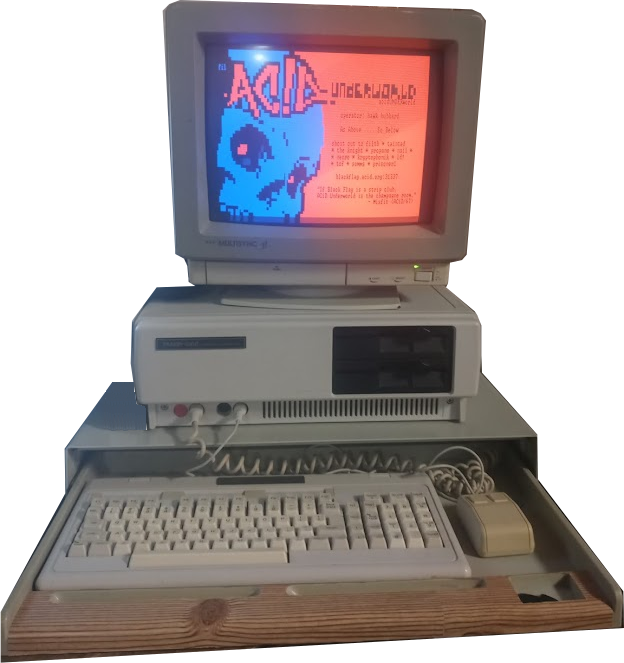 Build Blog 
|
Quick
Specs
The Tandy 1000A was bought at Value Village in Everett, WA for $10 in late 2007. It has since become the main "XT" of the fleet, gradually, over time. I use this computer mostly for Bulletin Board System surfing and for playing very old DOS games that either make use of the Tandy's expanded sound and CGA video capabilities, and of course making my #SepTandy videos on YouTube. To me, the Tandy 1000 Series is one of the quint-essential vintage PC's to use for retro-gaming because even this early 1000A from 1985 is quite capable with a bumped up V20 CPU and 8087 Math Co-Processor. It's actually an extremely clean example. The NEC MultiSync II CRT Monitor it uses is a monitor I picked up for free from "Computer Surplus" in Redmond WA back in 2017 and repaired myself as the analog/TTL switcher board module in the back had a cracked connection where the RGB cable plugged in. My repair has really lasted well with the massive ton of bodge wires I've thrown on it. |
1991
Compaq Deskpro 386s/20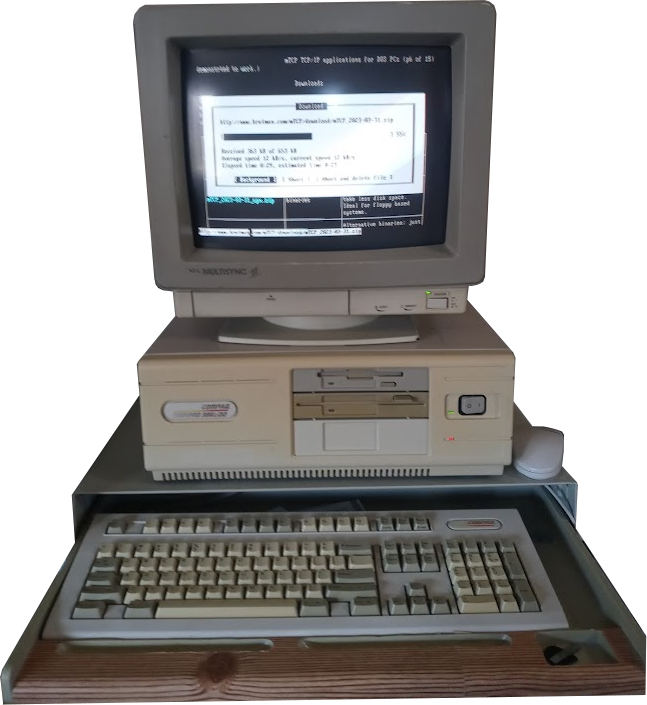 Build Blog 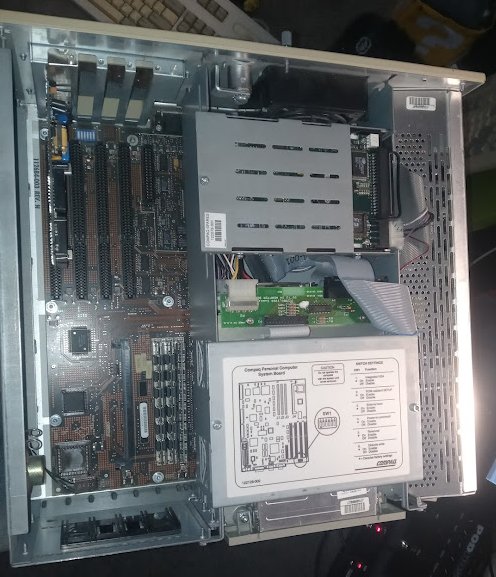
|
Quick
Specs
I got this souped up Compaq Deskpro 386s/20 from a colleague from work who was moving and needed to get rid of it. It was free. It had Linux on it (Slackware IIRC), and 10MB of RAM, a lot for a 386 SX. However, the impressive center-point of the whole system is the extremely rare and hard-to-find Evergreen Technologies RevTo486 upgrade chip in it featuring an IBM "Blue Lightning" 486 BLX3 SLC clock tripled CPU, which was designed to run at 75MHz, but it runs at around 60 MHz in this system, giving it performance on par a faster DX2-66 system - with a small bottleneck from the 387 SX Co-PRocessor I installed as well. Now it runs MS-DOS 6.22 straight up - no Windows, and is mostly used for the "Golden Age" DOS games, as well as surfing the web in text mode using Links, surfing bulletin boards, and other various internet related tasks. It's also just a cool system because it's about 75% complete, I have a bewer N.O.S. Logitech Compaq branded mouse on it, and a Micron CRT monitor, while it uses the original Compaq PS/2 rubber dome keyboard with software adjustable "clicker" for the keys that plays through the internal speaker.
|
1992 BSI (NanTan) FMA3500C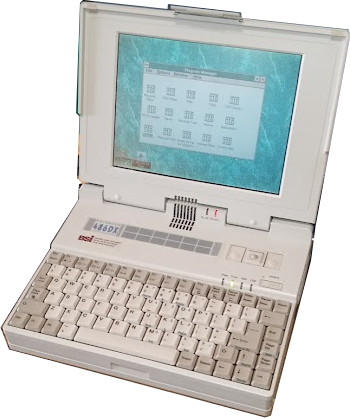
Build Blog 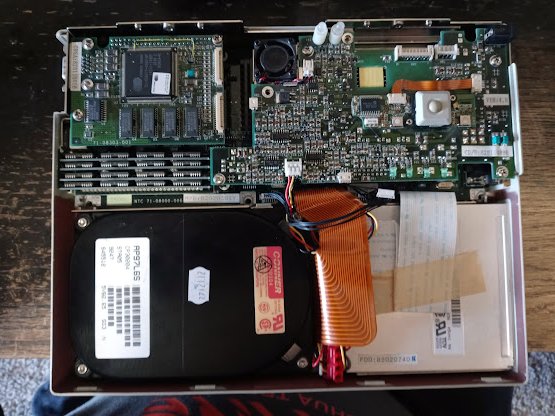 |
Quick
Specs
I bought this uncommon and kind of interesting re-branded NanTan Notebook FMA3500C (sold as a BSi NB486DX33) in 2022 off e-bay as sort of an interesting piece of computing history. I used to have the monochrome version of this laptop but this version with the very very strange trackball, lack of PCMCIA sloots, and a huge NiCad battery in the back that screws on with thumbscrews makes for a very intriguing system. It's got a FSTN Color screen on it that hardly ghosts at all, and is very bright and crisp, with only minor eyestrain at times. Everything on it works currently except the Varta CMOS battery which has, of course, spilled its guts (not too badly though) and is dead, but otherwise, the system works about 92.2% with the CMOS Battery and the original NiCad battery pack (easily replaceable with another 2 pin 12VDC Battery Pack snap-in replacement) needing replaced. THe original battery pack worked for about a week before it developed an internal short and prevents the computer from starting up as a result when installed. Of course there's no PCMCIA Slots, and a toggle switch for the PS/2 port on it, making for a really interesting and janky design. I have plans to put a parallel port sound card device on it and a Serial WiFi Modem on it so it can join the others in the internet hijinks. I like funky little old laptops like this, and the challenges of hot-rodding them. I'm also plotting putting an 8GB HDD or SSD in there at some point since it does not play well with huge ATA-133 HDDs, but has some serious potential. Maybe even a DX4 upgrade with gobs of SIP RAM. I might be keeping this one at work for testing serial port functionality on medical devices. Just seems like it would have a good legit job for this, even if it's just playing baseball with text files over Interlnk as a test function. |
1995 NanTan Notebook FMAK9200D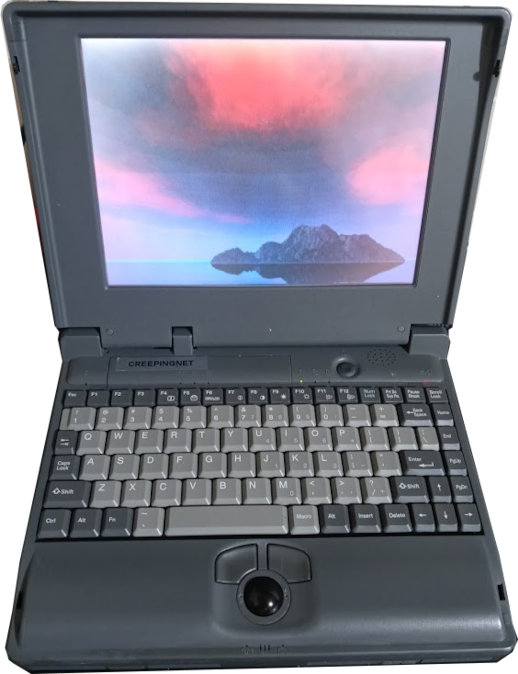 Build Blog 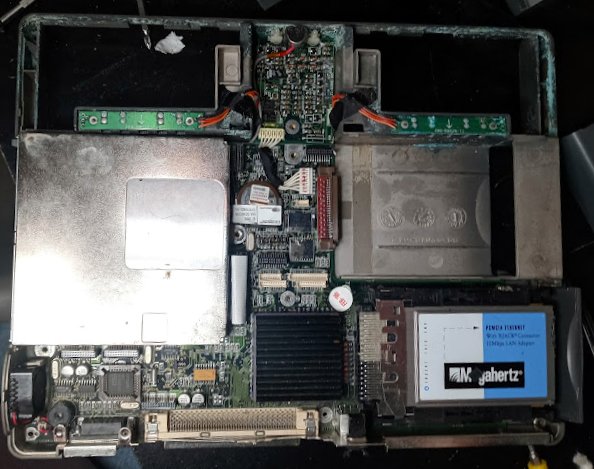 |
Specs
I bought this on e-bay as a "parts basketcase" machine in 2022 when it came up for dirt cheap. Just a generic, unbranded, color NanTan Notebook FMAP9200D. Turns out all that was wrong with it was the previous owner did not know you press FN+Contrast Up to make the screen visible at boot time. It does get better as it runs, so it likely needs a recap in some places. It has a beat to crap floppy out of one of my NEC Versa laptops installed in it as the original was dead. The internal speaker had to be re-soldered in place due to a factory defect. Otherwise, it runs great as is. The FMAK9200 series is one of my favorite and underrated vintage laptop computers for DOS and early Windows retrogaming, and they frickin' SCREAM! I'd compare them to a PC Chips M912 with a real cache - very fast for what it is, but stability can be a little wonky at times. IT still needs some work though - the battery PCBs need bodge wired and repaired, the batteries themselves need re-celled or replaced, and some re-capping might be needed in the video circuit, but otherwise, one of my favorite vintage Laptops, this and my Versa M/75 are tied - but I like this one better from a sound standpoint because it has an ESS488 AudioDrive chip in it with OPL so I can play games with full sound on this one without soldering and wacky chicanery. |
1994
NEC Versa M/75CP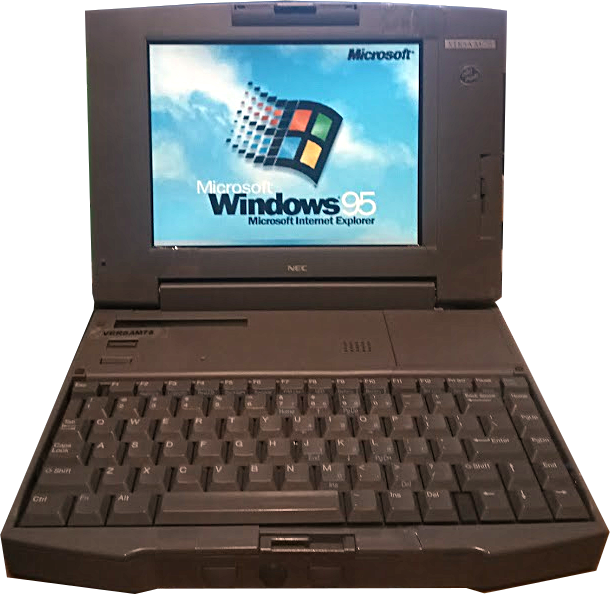 Build Blog 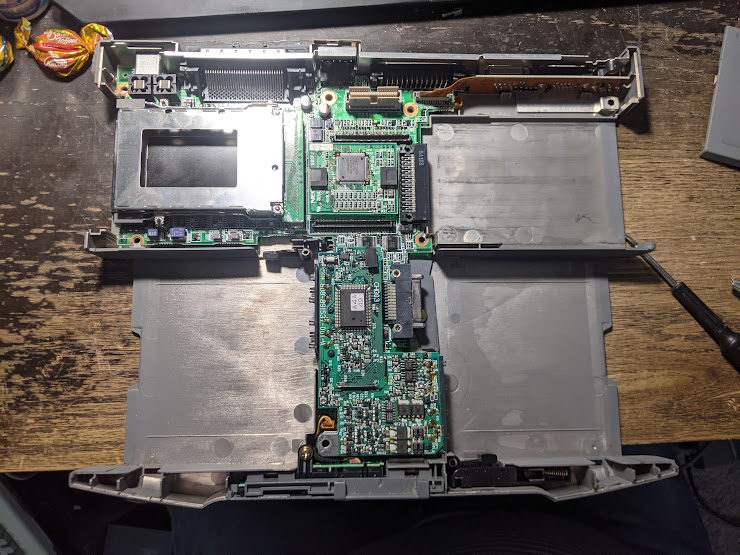 |
Specs
This is a frankenstein of 2 different Versa M/75s I put together. The first one was a Versa M/75CP that came with a Words+ System 2000 AAC and the very very rare NEC Versa Pen/Touch feature that featured a (cracked) 3M Digitzer panel, and could use a active wired stylus. I have chosen to dilligently keep this Pen/Touch enabled removable panel in one piece. For awhile I looked at using an 800x600 panel in it, and managed to, but decided after the great destruction incident of December 2022, that I would use parts from another dead Versa I parted out to rebuild this one back to it's stock form. The base plastics and some of the internals came from a NEC Versa M/75TC I got in 2021. THe only work left is the digitizer. I'm also having problems with one of the PCMCIA ports on it, kind of a shame because I have been hacking a Panasonic Sound/SCSI KXL-D20 card to add adlib and SoundBlaster support to this laptop computer along side it's Crystal CS-4231-KQ Chipset audio. Other than that, it's a beast of a laptop, runs anything I throw at it, and is so rock stable It's kind of unstoppable. I use this one the most, for gaming, web surfing, downloading files, visiting Bulletin Board Systems, file management, authoring the websites a little bit - just a ton of stuff. It's basically the laptop equivalent of my 486 Desktop system. |
1995
NEC Versa P/75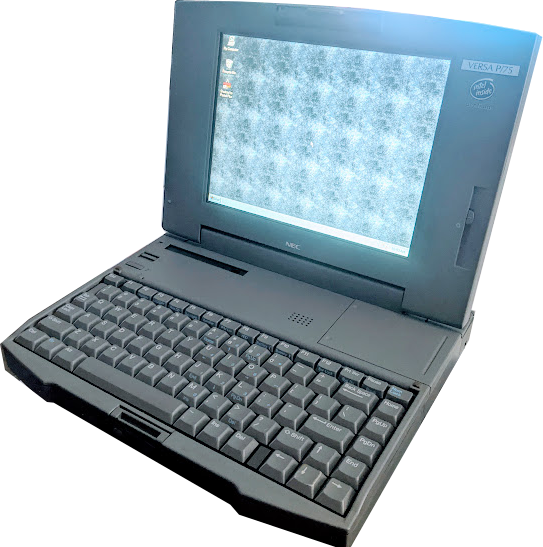 Build Blog 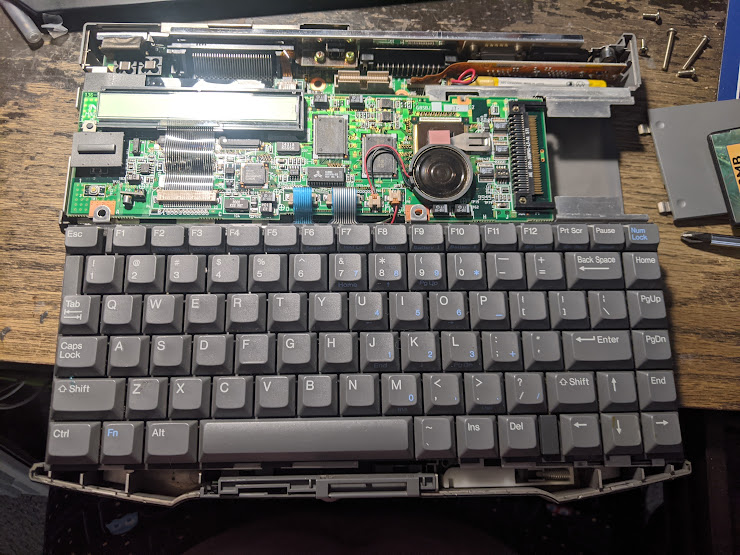 |
Specs
I bought this last edition of the original Versa on e-bay in 2020 for about $25 untested, as/is "for parts or repair". This is the one that has been going for 3 years with a case patched together with superglue and baking soda (and has a 3-hour video fo it's repair on YouTube). This is my lone Pentium/Win9x system of the lot that's dedicated to that. So it's used to run stuff I cannot run or that does not run as well on the M/75. I may part with it at some point - or not - but for now I'm keeping it because it's a good little 800x600 laptop computer that's pretty darned reliable. Also, it has SoundBlaster compatible sound, unlike the M/75. |
1995
486 DX4-100 Desktop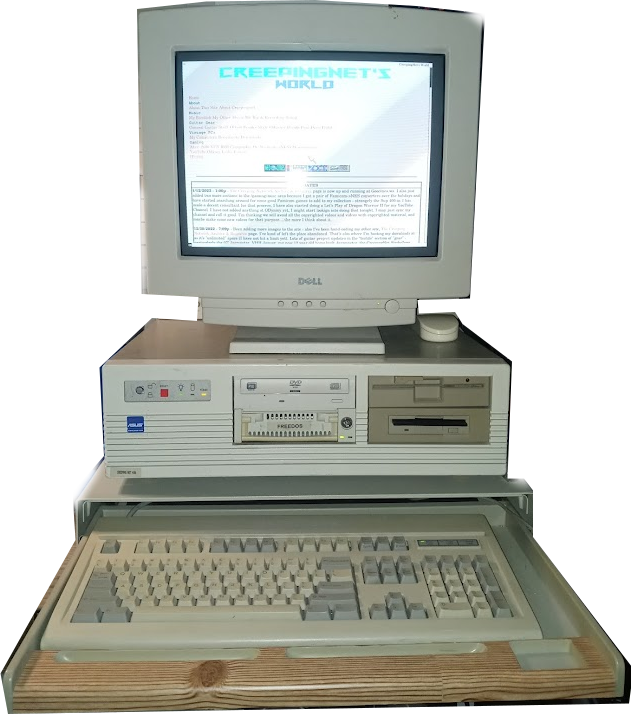 Build Blog 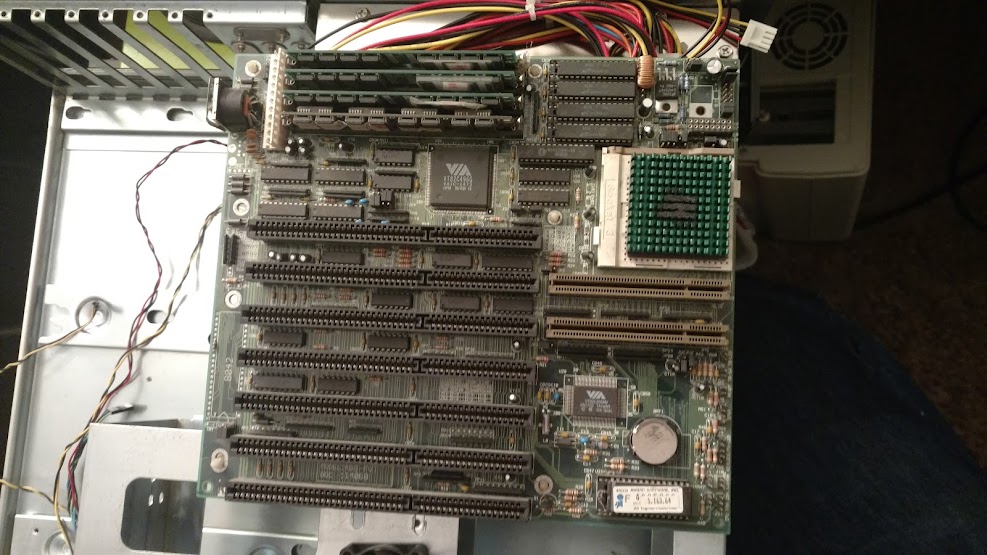 |
SPECS
CreepingNet 486 is my main desktop. This case has been 3 different computers since 2004 (CreepingNet P200MMXT, then CreepingNet XT II, and this one). It's a SongCheer XT Case with a J.D.R. Power Supply in it. The motherboard is a FIC 486-PVT with a Am486 DX4-100 in it, 512K L2 Cache, and 64MB of RAM. It's the beastiest vintage PC I have and it's literally almost a tweener and quasi-modern daily driver. I try all sorts of crazy experiments with this computer, most of them successful, including (but not limited to): Running Firefox on it (yep, a 486 that runs Firefox from the early 2010's - albeit slowly), almost launching Five Nights at Freddy's in Windows 95 (the title screen came up for a few seconds WITH sound), recording multitrack digital audio at CD quality in CakeWalk 5 Pro Audio, Running 128GB-256GB SATA HDDs using a SATA Converter (Windows 95 boots in 34 seconds on that setup, even if you shut down improperly), Destroying a Pentium in the Frame Rate department in networked Doom Games, almost running YouTube Videos in Windows 3.11 For Workgroups using a plugin from Firefox for Windows 7 in Opera 3.62 (back when YouTube still had flash), Running Super Nintendo Emulators just fast enough to be fun.....the fun never ends with this thing. EVery time I think I've hit a ceiling, it just keeps on going through it and finding a new level of insanity. This system is basically everything I learned during my "Creeping Network" days rolled into a ball and put together. The one true keeper of this collection for me is this one, it just does so much insane stuff that nobody else with a 486 would dare attempt. |